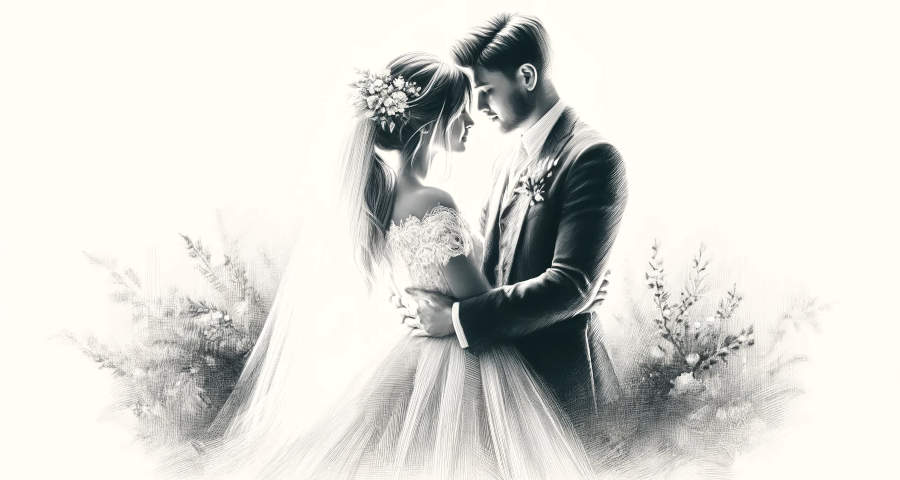In Stephen Covey’s The 7 Habits of Highly Effective People, one of the key principles is starting with the end in mind.
When it comes to wedding planning, this translates into establishing a clear vision for your big day.
A well-defined wedding vision acts as a blueprint or roadmap, guiding all your decisions throughout the planning process.
This ensures that every detail contributes to the overall atmosphere and experience you aim to create, helping you make choices that truly align with your desires for your special day.
What is a wedding vision?
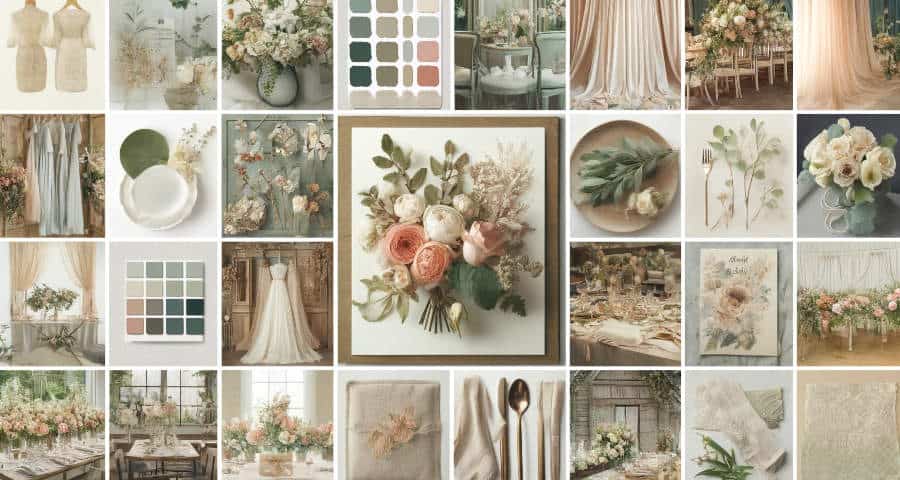
A wedding vision defines the overall theme and style you envision for your wedding day.
It establishes a cohesive look and feel that guides your choices, from the venue to the flowers, and even the attire.
This cohesive concept shapes not only the appearance of your wedding but also the atmosphere experienced by your guests.
Having a clear wedding vision ensures that every element works harmoniously towards a unified theme.
This unity not only enhances the beauty and immersion of your wedding but also simplifies the planning process.
With a distinct vision, you can swiftly determine what fits and what doesn’t, which saves time and reduces stress.
The Impact of a Wedding Vision
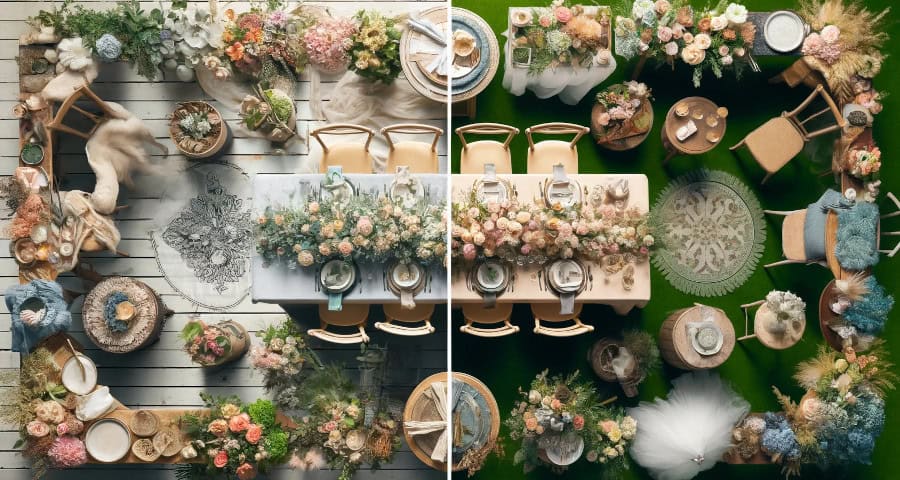
Imagine two weddings.
In the first, the couple has a clear vision of a romantic, rustic barn wedding with a colour palette of blush, ivory, and sage green. From the save-the-dates to the table settings, every element reflects this vision, creating a cohesive and enchanting atmosphere. Guests feel immersed in the couple’s love story, and the day unfolds seamlessly.
In contrast, the second couple hasn’t established a clear vision. They choose a beautiful venue but struggle to make decisions about decor, flowers, and other details. The result is a mishmash of colours and styles that lack cohesion. While still a joyous occasion, the wedding feels disjointed, and the couple feels stressed throughout the planning process, questioning whether their choices truly reflect their desires.
This comparison highlights why a wedding vision is so crucial. It not only ensures that your wedding day is visually pleasing and cohesive but also significantly impacts the overall experience for both you and your guests.
Reflect on Your Relationship and Priorities

Now that you understand the importance of a wedding vision, the next step is to reflect on your relationship and priorities.
Before diving into the details of colours, venues, and guest lists, take a step back and consider what truly matters to you and your partner.
This reflection isn’t just about creating a day that looks beautiful but crafting an experience that feels meaningful and celebrates your unique relationship.
Start by discussing with your partner what your ideal wedding day would look like.
Which elements are most important to each of you? Is it the location, the number of guests, the style of the ceremony, or perhaps the entertainment and food?
Understanding each other’s desires is crucial to creating a day that reflects both of your personalities and values.
Reflect on the moments in your relationship that define you as a couple.
Perhaps it’s a memorable trip, a shared passion, or a challenging time you navigated together.
These experiences can inspire themes, readings, or rituals that are deeply personal and add immense meaning to your wedding celebration.
Once you have identified the elements that hold special significance, prioritise them in your planning process.
This might mean allocating more of your budget to a spectacular venue that means a lot to you or ensuring that the ceremony reflects your shared values.
It’s okay to diverge from traditional expectations if it means having a wedding that feels right for you.
Remember, marriage is about union and compromise, and planning your wedding is often the first exercise in balancing individual needs and desires within your relationship.
Consider each decision carefully, ensuring that it honours both of your visions.
This balance will not only make your wedding more harmonious but also strengthen your bond as you make these important decisions together.
Questions to Guide Your Reflection

To help you and your partner effectively reflect on your relationship and what you want your wedding to represent, here are some sample questions that can guide your discussion:
- What are the top three aspects of your wedding that are most important to each of you? Identifying these priorities early can help ensure that your planning decisions align with what truly matters to both of you.
- Describe a moment in your relationship that you would like to honour or reflect in your wedding celebration. This could be a shared experience, a significant milestone, or a personal memory that has special meaning for both of you.
- How can you ensure that your wedding vision represents both of your personalities and values equally? Consider ways to blend your tastes and preferences so that the wedding feels equally reflective of both partners.
- What traditions or cultural elements do you want to incorporate and why? Discussing this will help you identify meaningful ways to celebrate your heritage or blend different cultural traditions.
- How do you want your guests to feel during the wedding? This question focuses on the emotional atmosphere and guest experience, which are crucial aspects of your wedding vision.
Gather Inspiration
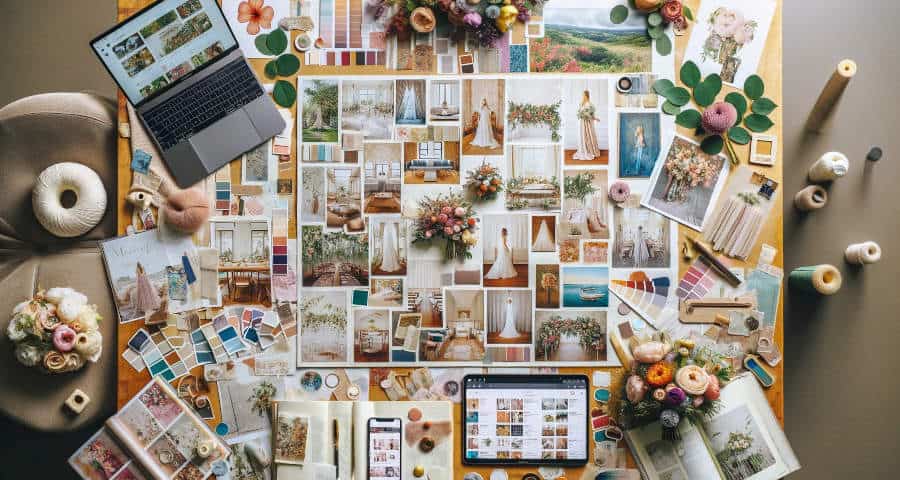
The world is full of inspiration, and with so many resources at your fingertips, the possibilities are endless. Here are some of the best places to start your search:
- Wedding Magazines and Blogs: These are treasure troves of ideas, showcasing everything from the latest trends to timeless classics.
- Pinterest: This visual search engine allows you to create boards for different aspects of your wedding, such as attire, decorations, and colour schemes.
- Instagram and Social Media: Follow wedding planners, venues, and floral designers for daily doses of creativity.
- Real Weddings: Attend weddings, or view galleries online to see how other couples have personalised their celebrations.
- Nature and Art: Draw inspiration from the beauty around you, whether it’s the colours of a sunset or the design of a piece of art.
While gathering inspiration, it’s important to keep an open mind. You might find yourself drawn to themes or ideas you hadn’t considered before. Allow yourself to explore various styles and concepts before narrowing down your choices. This process is about discovering what resonates with you and your partner.
After gathering a substantial amount of inspiration, take a step back to reflect. Discuss with your partner which ideas best fit your vision and values. This is a good time to start thinking about how these ideas will work within your budget and venue constraints. Refining your inspiration into a clear and achievable vision is crucial for moving forward with vendors and other planning details.
Creating Your Unique Wedding Vision

Begin by reflecting on the journey you and your partner have shared. What are the moments, interests, or passions that define your relationship? Use these elements as the foundation for your wedding vision. Whether it’s a shared love for the outdoors, a passion for art, or a fond memory of where you first met, these personal touches can guide your choices and make your wedding truly memorable.
Your wedding vision can include specific elements that tell your story. Consider incorporating aspects such as:
- Music: Choose songs that have special meaning for your relationship, or perhaps hire a band that plays music from a significant time in your life.
- Decor: Include decor elements that reflect your shared interests or significant places. For instance, if you both love the beach, consider a seaside theme with sand and shell decor.
- Food and Drink: Customise your menu to include your favourite dishes or cocktails from memorable dates.
By thoughtfully integrating these aspects, you can create a wedding that not only represents your unique story but also presents a polished and unified vision to your guests.
While traditional wedding themes provide a great starting point, don’t be afraid to think outside the box. Mix elements from different themes, or create something entirely new that doesn’t fit into a conventional category. This approach can lead to a truly unique and memorable wedding.
While infusing your wedding with personal touches is important, maintaining a cohesive vision is equally crucial. To ensure that your wedding feels unified and well-thought-out, consider selecting a colour palette, theme, or motif that ties the various elements together. For example:
- Colour Palette: Choose colours that reflect your personal tastes but also harmonise well together. Use these colours consistently across your decor, attire, and stationery to create a visually cohesive experience.
- Theme or Motif: If you have diverse interests, select a theme or motif that can act as a thread connecting these elements. Whether it’s a vintage style, a floral motif, or a modern minimalist approach, let this theme guide your decisions to ensure a consistent look and feel.
- Harmonising Elements: When introducing elements that are deeply personal, like heirlooms or cultural artefacts, think about how they can complement rather than clash with your overall design. This might mean adapting these items with colour-matched materials or displaying them in a manner that aligns with your wedding’s aesthetic.
Wedding planners, designers, and other vendors have a wealth of experience and can offer creative ideas that you might not have considered. Share your story and ideas with them, and they can help you bring your unique vision to life while ensuring that everything runs smoothly.
Consider how the elements of your wedding will engage your guests. Create interactive experiences or thoughtful touches that will make the event enjoyable and memorable for everyone involved. This could include interactive food stations, personalised favours, or fun activities that reflect your interests.
Remember to have fun and enjoy the process. This is a special time in your life, and planning your wedding is a unique opportunity to express your love story creatively. Each decision you make is a reflection of your journey together and a celebration of your future.
Creating a Vision Board
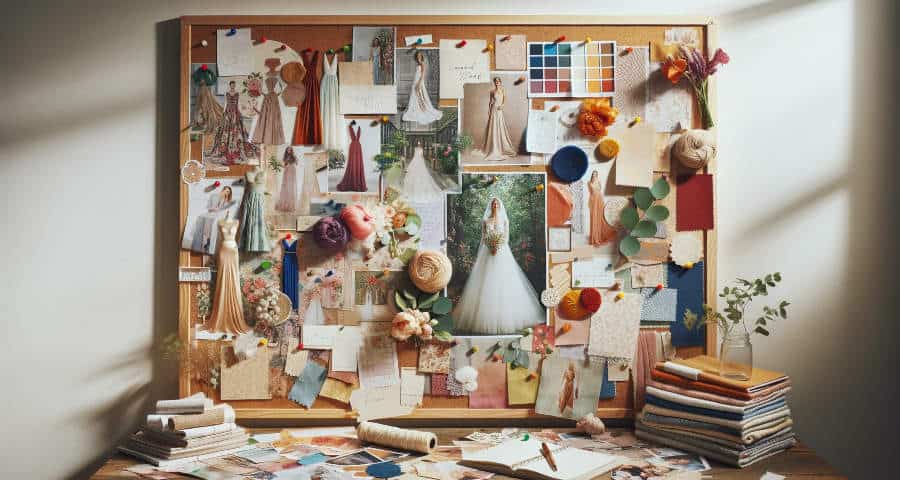
Creating a vision board is a crucial first step in planning your wedding, as it helps visualise your goals and dreams for the big day. Once you’ve gathered your collection of images, materials, and text, decide whether your vision board will be physical, like a cork board or scrapbooking album, or digital, like a Pinterest board. Each type has its benefits, and your choice will depend on your preference for visualising and organising ideas.
Physical Vision Boards: Offer a tangible experience where you can touch and rearrange elements, which many find satisfying and inspiring. Consider using a cork board, poster board, or even a scrapbook as the base of your vision board. This format allows you to physically arrange and rearrange items as your ideas evolve, providing a hands-on approach to visualising your wedding day.
Digital Vision Boards: Are versatile and easy to share, making them ideal for coordinating with wedding planners and vendors remotely. Tools like Pinterest, Canva, or Trello facilitate easy drag-and-drop of images and adjustment of layouts, supporting a dynamic planning process.
As you organise your vision board, include images that depict your overall style and colour scheme, pictures of attire and accessories, photos of potential venues and decor ideas, and visual representations of floral arrangements and table settings. Incorporate elements that capture the mood you want to evoke at your wedding.
Enhancing Your Vision Board
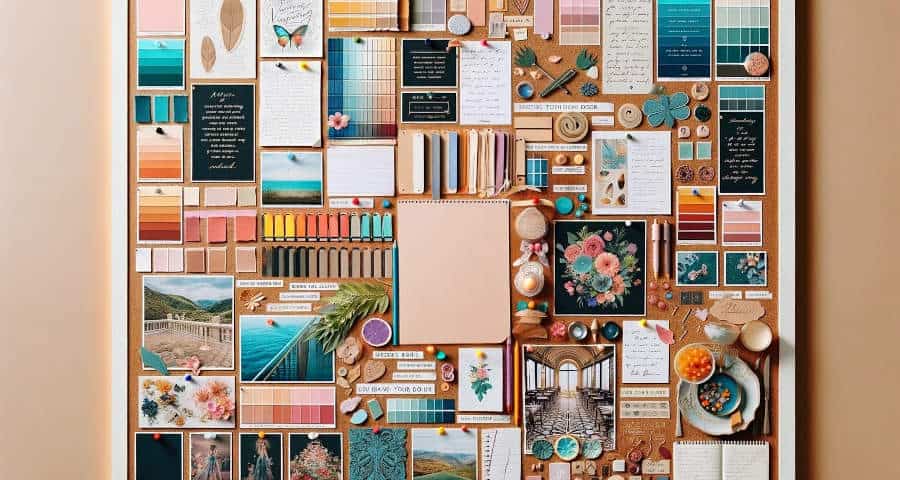
To create a more cohesive and inspiring vision board, consider the following tips:
- Consistent Colour Scheme: Use a consistent colour palette throughout your vision board to ensure a unified look. This helps maintain a clear and coherent style that reflects your wedding theme.
- Inspirational Elements: Include inspirational quotes, song lyrics, or personal mementos that resonate with your wedding vision. These can serve as a source of inspiration and remind you of the deeper meaning behind your special day.
- Organised Sections: Divide your vision board into distinct sections or categories, such as attire, venue, food, and decor. This organisation makes it easier to reference and plan each aspect of your wedding, ensuring that nothing is overlooked.
Remember, your vision board isn’t static. It should evolve as your ideas become more refined. Regularly update your board to reflect new choices and remove elements that no longer fit, keeping your planning focused and aligned with your evolving vision.
Sharing Your Vision

Sharing your vision allows you to align expectations, garner support, and ensure that everyone involved understands and embraces the overarching goals and atmosphere you aim to create on your special day. Begin by sharing your vision with key stakeholders such as parents, bridal party members, and close family members. Schedule dedicated time to sit down with each individual or group to articulate your vision clearly. During these discussions, openly talk about their roles and contributions, encourage open communication, and listen to their feedback and suggestions, taking into account their perspectives while staying true to your vision.
Your vendors play a crucial role in executing your wedding vision, from the venue and caterers to the florist and musicians. When meeting with vendors, communicate your vision clearly and provide them with any inspiration or mood boards you’ve created. Be open to their expertise and ideas, but ensure that they understand your priorities and preferences. Establishing a collaborative relationship with vendors fosters teamwork and ensures that everyone is working towards a unified vision.
To facilitate better communication across all parties, create a detailed document or digital presentation that outlines your wedding theme, colour palette, and the atmosphere you want to create. Share this with your stakeholders and vendors. As plans evolve, keep everyone informed through emails or quick calls to ensure that all changes are communicated and understood. Regularly schedule sessions to gather feedback and discuss any concerns, which helps in addressing issues promptly and keeping everyone engaged.
By ensuring that everyone from family members to professional vendors are on the same page, you can create a cohesive and memorable experience that truly reflects your vision for the big day.
Staying True to Your Vision

Regularly revisiting the discussions about what you both want your wedding to represent is vital.
While keeping up with the latest wedding trends can provide some great ideas, it’s important not to let these external influences steer you away from your true preferences.
Trends come and go, but your wedding memories will last a lifetime.
If a current trend fits seamlessly with your vision, feel free to embrace it.
However, if it doesn’t resonate with you, trust your instincts and focus on what feels right for your celebration.
Every choice you make, from the venue to the vendor, should align with your initial vision.
Don’t be swayed by well-meaning family and friends who might have their own ideas of what your wedding should look like.
Politely acknowledge their suggestions, but make decisions based on what you and your partner have envisioned.
This alignment ensures that your wedding day feels authentic and personal.
Often, the right choice is the one that feels right. When faced with decisions, trust your gut instinct.
If something doesn’t feel like it fits your vision, it probably doesn’t.
Your instinct is a powerful guide in ensuring your wedding day turns out as you’ve dreamed.
Remember what truly matters: celebrating your love with the people who matter most.
When you feel overwhelmed, take a step back and remind yourself of the real purpose of your big day.
Once you have defined your wedding vision, the next step is to set your wedding budget. Establishing a budget early on ensures that your vision is achievable and helps guide your decisions throughout the planning process. For detailed guidance on how to set and allocate your wedding budget, check out our post on Setting Your Wedding Budget.

